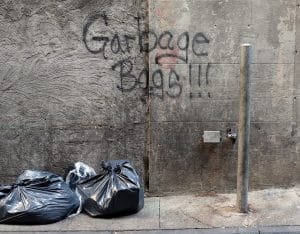Why can’t Garbage Bags Be Made from 100% Recycled Plastic?

Question: Why can’t Garbage Bags Be Made from 100% Recycled Plastic? They can, but they don’t have the strength of their predecessor, virgin plastic.
To combat this, some manufacturers mix virgin plastic with recycled plastic to enhance the strength or durability of the bags. Here’s how it works. And the pros and cons of making them from 100% recycled materials:
Process of Recycling Plastics (Bags)
- Collection: Plastic waste, including used plastic bags, bottles, and other materials, is collected from recycling bins or other sources.
- Sorting and Cleaning: The collected plastics are sorted by type and color, then thoroughly cleaned to remove any contaminants, like food residue or labels.
- Shredding: The cleaned plastics are shredded into small flakes or pellets to prepare them for processing.
- Melting and Reforming: These flakes or pellets are melted down and reformed into new plastic resin, which is then extruded to create plastic film that can be used to make new products, such as garbage bags.
- Manufacturing: The recycled plastic film is shaped and manufactured into new garbage bags, either partially or fully made from recycled content.
Upsides of 100% Recycled Plastic Bags
- Environmental Benefits:
- Reduction in plastic waste: Utilizing post-consumer recycled plastic reduces the demand for new plastic production, lowering the carbon footprint.
- Circular economy: Recycling plastic supports the reuse of resources, reducing reliance on virgin materials and diverting waste from landfills and oceans.
- Conservation of resources: Using recycled plastic reduces the need for fossil fuels in producing virgin plastic.
- Energy Savings: Producing recycled plastic typically consumes less energy than manufacturing new plastic from raw materials.
- Marketing and Consumer Appeal: Consumers are increasingly looking for sustainable options, so 100% recycled plastic products can attract eco-conscious buyers.
Downsides of 100% Recycled Plastic Bags
- Durability Concerns:
- Strength and quality: Recycled plastics can sometimes be less durable or have inconsistent quality compared to virgin plastic. This can result in bags that are thinner or more prone to tearing, though modern manufacturing techniques have improved this.
- Contamination:
- Lower-quality materials: If the recycling process doesn’t fully remove contaminants, the resulting plastic may be of lower quality. This can limit the bag’s strength or performance.
- Cost:
- Production costs: While recycling can save on raw material costs, the sorting, cleaning, and reprocessing steps can make the production of recycled plastic bags more expensive. This may result in higher prices for consumers, though this can vary based on location and production methods.
- Supply Limitations:
- Availability of recycled materials: The supply of high-quality recycled plastic is not always sufficient to meet demand, which could limit production scalability.
So What’s Clear?

Making garbage bags from 100% recycled plastic has clear environmental benefits, but the trade-offs include potential compromises in durability and higher production costs. As recycling technologies continue to improve, more manufacturers are moving towards producing high-quality products from 100% recycled materials. However, for now, many still mix virgin and recycled plastics to balance cost and performance.
I couldn’t find 100% recycled waste bags at any of my usual offline and online shopping haunts. 50% was as good as it gets.
